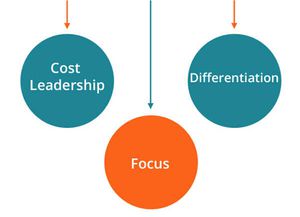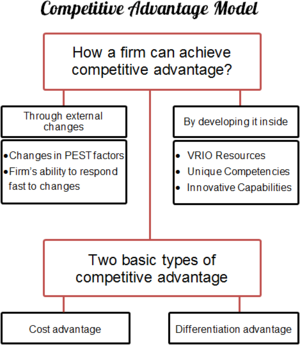Competitive Advantage
Business Dictionary defines Competitive Advantage as a "superiority gained by an organization when it can provide the same value as its competitors but at a lower price, or can charge higher prices by providing greater value through differentiation." Competitive advantage results from matching core competencies to the opportunities.[1]
Determining Factors of Competitive Advantage
How Can You Create Competitive Advantage[2]
To create a competitive advantage, you've got to be clear about these three determinants.
- Benefit. What is the real benefit your product provides? It must be something that your customers truly need and that offers real value. You must know not only your product's features, but also its advantages how they benefit your customers. That means being constantly aware of new trends that affect your product, especially new technology. For example, newspapers were slow to respond to the availability of free news on the internet. They thought people were willing to pay for news delivered on a piece of paper once a day.
- Target market. Who are your customers? What are their needs? You've got to know exactly who buys from you, and how you can make their life better. That’s how you create demand, the driver of all economic growth. Newspapers' target market drifted to older people who weren't comfortable getting their news online.
- Competition. Have you identified your real competitors? That's more than just similar companies or products. It includes anything else your customer could do to meet the need you can fulfill. Newspapers thought their competition was other newspapers until they realized it was the internet. They didn't know how to compete with a news provider that was instant and free.
Competitive Advantage Strategy
Strategies for Competitive Advantage[3]
There are three strategies for establishing a competitive advantage: Cost Leadership, Differentiation, and Focus (Cost-focus and Differentiation-focus).

source: Corporate Finance Institute
- Cost Leadership: In a cost leadership strategy, the objective is to become the lowest-cost producer. This is achieved through large-scale production where companies can exploit economies of scale. If a company is able to utilize economies of scale and produce products at a cost lower than competitors, the company is then able to establish a selling price that is unable to be replicated by companies. Therefore, a company adopting a cost leadership strategy would be able to reap profits due to its significant cost advantage over its competitors.
- Differentiation: In a differentiation strategy, a company’s products or services are differentiated from that of its competitors. This can be done by delivering high-quality products or services to customers or innovating products or services. If a company is able to differentiate successfully, the company would be able to set a premium price on its products or services.
- Focus: In a focus strategy, a company focuses its product or services toward a narrow target market segment. This strategy is successful if customers have different needs and want and the company is able to successfully create products/services that can cater to these customers. The focus strategy also has two variants;
- Cost-focus: Lowest-cost producer in a narrow market segment
- Differentiation-focus: Differentiated products/services in a narrow market segment
Types of Competitive Advantage
What are the Different Types of Competitive Advantage?[4]
Competitive advantages generate greater value for a firm and its shareholders because of certain strengths or conditions. The more sustainable the competitive advantage, the more difficult it is for competitors to neutralize the advantage. The two main types of competitive advantages are comparative advantage and differential advantage.
- Comparative Advantage: A firm's ability to produce a good or service more efficiently than its competitors, which leads to greater profit margins, creates a comparative advantage. Rational consumers will choose the cheaper of any two perfect substitutes offered. For example, a car owner will buy gasoline from a gas station that is 5 cents cheaper than other stations in the area. For imperfect substitutes, like Pepsi versus Coke, higher margins for the lowest-cost producers can eventually bring superior returns. Economies of Scale, efficient internal systems, and geographic location can also create comparative advantage. A comparative advantage does not imply a better product or service, though. It only shows the firm can offer a product or service of the same value at a lower price. For example, a firm that manufactures a product in China may have lower labor costs than a company that manufactures in the U.S., so it can offer an equal product at a lower price. In the context of international trade economics, opportunity cost determines comparative advantages. Amazon is an example of a company focused on building and maintaining a comparative advantage. The e-commerce platform has a level of scale and efficiency that is difficult for retail competitors to replicate, allowing it to rise to prominence largely through price competition.
- Differential Advantage: A differential advantage is when a firm's products or services differ from its competitors' offerings and are seen as superior. Advanced technology, patent-protected products or processes, superior personnel and a strong brand identity are all drivers of differential advantage. These factors support wide margins and large market shares. Apple is famous for creating innovative products, such as the iPhone, and supporting their market leadership with savvy marketing campaigns to build an elite brand. Major drug companies can also market branded drugs at high price points because they are protected by patents.
Competitive Advantage Model
Basic Competitive Advantage Model[5]
The following diagram illustrates the basic competitive Advantage Model:

source: Strategic Management Insight
An organization can achieve an edge over its competitors in the following two ways:
- Through external changes. When PEST factors change, many opportunities can appear that, if seized upon, could provide many benefits for an organization. A company can also gain an upper hand over its competitors when its capable to respond to external changes faster than other organizations.
- By developing them inside the company. A firm can achieve cost or differentiation advantage when it develops VRIO resources, unique competences or through innovative processes and products. The following resources have VRIO attributes:
- Intellectual property (patents, copyrights, trademarks)
- Brand equity
- Culture
- Know-how
- Reputation
M. Porter has identified 2 basic types of competitive advantage: cost and differentiation advantage. The cost leadership and differentiation strategies are not the only strategies used to gain competitive advantage. Innovation strategy is used to develop new or better products, processes or business models that grant competitive edge over competitors.
Internal Factors of Competitive Advantage
The Underlying Internal Factors of Competitive Advantage[6]
Positioning is an important marketing concept. The main purpose of positioning is often to create the right perceptions in comparison to competitors. Thus, it creates competitive advantage. This positioning, or competitive advantage, is based on creating the right "image" or "identity" in the minds of the target group. This positioning decision exists of selecting the right core competencies to build upon and emphasize.
Therefore, both corporate identity and core competencies are underlying internal factors of competitive advantage.
- Corporate Identity: The operational model for managing corporate reputation and image of Gray and Balmer (1998) proposes that corporate identity, communication, image, and reputation the fundamental components of the process of creating competitive advantage. Corporate identity through corporate communication creates corporate image and reputation, with an end result of competitive advantage. Corporate identity is the reality of an organization. It refers to the distinct characteristics or core competencies of the organization. It is the mental picture of the company held by its audiences. Corporate communication refers to all the official and informal communication sources, through a variety of media, by which the company outsources its identity to its audiences or stakeholders. Corporate communication is the bridge between corporate identity and corporate image or reputation.
The above-stated process has two main objectives, namely to create the intended image in the minds of the company’s principal constituents and managing the process to create a favorable reputation in the minds of the important stakeholders. Gray and Balmer (1998) say that a strong image can be built through a coordinated image-building campaign and reputation, on the other hand, requires a praiseworthy identity that can only be shaped through consistent performance.
- Core Competencies: A core competency is a concept introduced by Prahalad and Hamel (1990). Core competencies are part of the corporate identity; they form the foundation of corporate competitiveness. The competitiveness of a company is based on the ability to develop core competencies. A core competency is, for example, a specialised knowledge, technique, or skill. Yang (2015) concluded, with the examination of a long-term development model, that developing core competencies and effectively implementing core capabilities are important strategic actions for any enterprise in order to pursue high long-term profits. In the end, real advantage can be created by the management’s ability to unify corporate-wide technologies and production skills into competencies that capacitate individual businesses to adapt quickly to changing opportunities.
To sustain leadership in a chosen core competency area, companies should seek to maximize their competency factors in the core products like being important in positioning its values, distinctive (differentiated), superior, communicable (visibility), unique, affordable, and profitable. When a company achieves this goal, it allows it to shape the evolution of an end market
See Also
- Business Strategy
- Five Forces Model
- Strategic Planning
- IT Optimization
- IT Strategy
- Competing Values Framework
- Competitive Analysis
- Competitive Intelligence (CI)
- Competitive Position
- Competitive Environment
- Competitive Advantage of Nations
- Competitive Advantage Framework
- Competitive Pricing
References
- ↑ Definition: What is Competitive Advantage? Business Dictionary
- ↑ What are the determining factors in creating Competitive Advantage? the balance
- ↑ What are the Strategies for for Gaining Competitive Advantage? CFI
- ↑ What are the Different Types of Competitive Advantage? Investopedia
- ↑ The Basic Competitive Advantage Model SMI
- ↑ What are the underlying internal factors of Competitive Advantage? Wikipedia
Further Reading
- The Competitive Advantage of Nations Michael E. Porter
- It's Official! The End Of Competitive Advantage Steve Denning
- How to Prolong Competitive Advantage Phebo Wibbens
- The Past and Future of Competitive Advantage Clayton M. Christensen
- The Challenges of Maintaining a Competitive Advantage Lee Frederiksen
- Competitive Advantage - Evolution and Challenges Ciobanu George, Dragomir Laurentiu, Barbu Catalin
